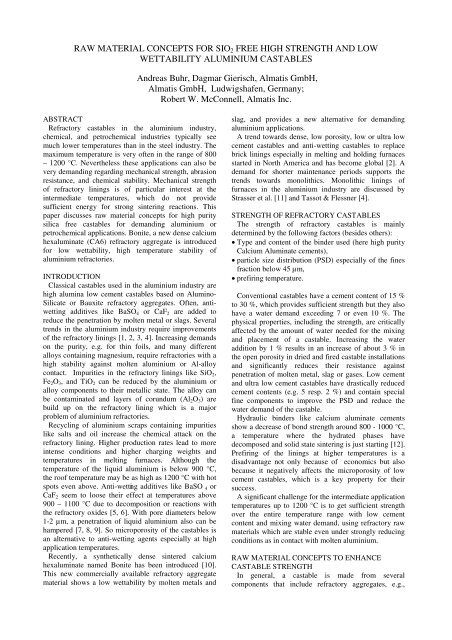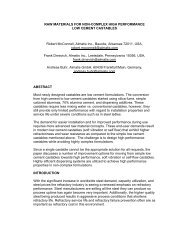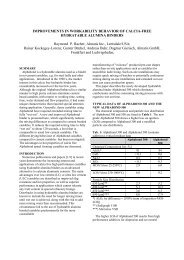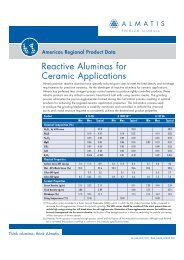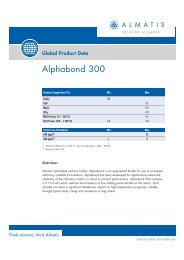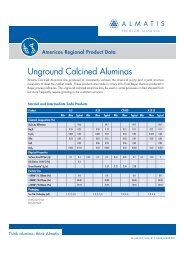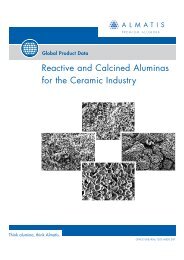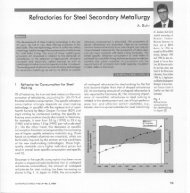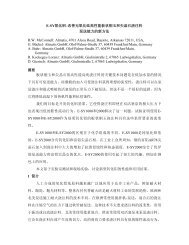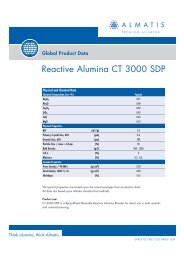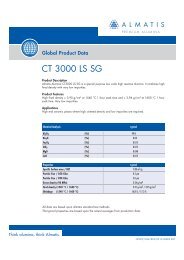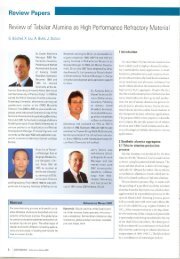Raw material concepts for sio2 free high strength - Almatis
Raw material concepts for sio2 free high strength - Almatis
Raw material concepts for sio2 free high strength - Almatis
You also want an ePaper? Increase the reach of your titles
YUMPU automatically turns print PDFs into web optimized ePapers that Google loves.
RAW MATERIAL CONCEPTS FOR SIO2 FREE HIGH STRENGTH AND LOW<br />
WETTABILITY ALUMINIUM CASTABLES<br />
ABSTRACT<br />
Refractory castables in the aluminium industry,<br />
chemical, and petrochemical industries typically see<br />
much lower temperatures than in the steel industry. The<br />
maximum temperature is very often in the range of 800<br />
– 1200 °C. Nevertheless these applications can also be<br />
very demanding regarding mechanical <strong>strength</strong>, abrasion<br />
resistance, and chemical stability. Mechanical <strong>strength</strong><br />
of refractory linings is of particular interest at the<br />
intermediate temperatures, which do not provide<br />
sufficient energy <strong>for</strong> strong sintering reactions. This<br />
paper discusses raw <strong>material</strong> <strong>concepts</strong> <strong>for</strong> <strong>high</strong> purity<br />
silica <strong>free</strong> castables <strong>for</strong> demanding aluminium or<br />
petrochemical applications. Bonite, a new dense calcium<br />
hexaluminate (CA6) refractory aggregate is introduced<br />
<strong>for</strong> low wettability, <strong>high</strong> temperature stability of<br />
aluminium refractories.<br />
INTRODUCTION<br />
Classical castables used in the aluminium industry are<br />
<strong>high</strong> alumina low cement castables based on Alumino-<br />
Silicate or Bauxite refractory aggregates. Often, antiwetting<br />
additives like BaSO4 or CaF2 are added to<br />
reduce the penetration by molten metal or slags. Several<br />
trends in the aluminium industry require improvements<br />
of the refractory linings [1, 2, 3, 4]. Increasing demands<br />
on the purity, e.g. <strong>for</strong> thin foils, and many different<br />
alloys containing magnesium, require refractories with a<br />
<strong>high</strong> stability against molten aluminium or Al-alloy<br />
contact. Impurities in the refractory linings like SiO2,<br />
Fe2O3, and TiO2 can be reduced by the aluminium or<br />
alloy components to their metallic state. The alloy can<br />
be contaminated and layers of corundum (Al2O3) are<br />
build up on the refractory lining which is a major<br />
problem of aluminium refractories.<br />
Recycling of aluminium scraps containing impurities<br />
like salts and oil increase the chemical attack on the<br />
refractory lining. Higher production rates lead to more<br />
intense conditions and <strong>high</strong>er charging weights and<br />
temperatures in melting furnaces. Although the<br />
temperature of the liquid aluminium is below 900 °C,<br />
the roof temperature may be as <strong>high</strong> as 1200 °C with hot<br />
spots even above. Anti-wetting additives like BaSO 4 or<br />
CaF2 seem to loose their effect at temperatures above<br />
900 – 1100 °C due to decomposition or reactions with<br />
the refractory oxides [5, 6]. With pore diameters below<br />
1-2 µm, a penetration of liquid aluminium also can be<br />
hampered [7, 8, 9]. So microporosity of the castables is<br />
an alternative to anti-wetting agents especially at <strong>high</strong><br />
application temperatures.<br />
Recently, a synthetically dense sintered calcium<br />
hexaluminate named Bonite has been introduced [10].<br />
This new commercially available refractory aggregate<br />
<strong>material</strong> shows a low wettability by molten metals and<br />
Andreas Buhr, Dagmar Gierisch, <strong>Almatis</strong> GmbH,<br />
<strong>Almatis</strong> GmbH, Ludwigshafen, Germany;<br />
Robert W. McConnell, <strong>Almatis</strong> Inc.<br />
slag, and provides a new alternative <strong>for</strong> demanding<br />
aluminium applications.<br />
A trend towards dense, low porosity, low or ultra low<br />
cement castables and anti-wetting castables to replace<br />
brick linings especially in melting and holding furnaces<br />
started in North America and has become global [2]. A<br />
demand <strong>for</strong> shorter maintenance periods supports the<br />
trends towards monolithics. Monolithic linings of<br />
furnaces in the aluminium industry are discussed by<br />
Strasser et al. [11] and Tassot & Flessner [4].<br />
STRENGTH OF REFRACTORY CASTABLES<br />
The <strong>strength</strong> of refractory castables is mainly<br />
determined by the following factors (besides others):<br />
Type and content of the binder used (here <strong>high</strong> purity<br />
Calcium Aluminate cements),<br />
particle size distribution (PSD) especially of the fines<br />
fraction below 45 µm,<br />
prefiring temperature.<br />
Conventional castables have a cement content of 15 %<br />
to 30 %, which provides sufficient <strong>strength</strong> but they also<br />
have a water demand exceeding 7 or even 10 %. The<br />
physical properties, including the <strong>strength</strong>, are critically<br />
affected by the amount of water needed <strong>for</strong> the mixing<br />
and placement of a castable. Increasing the water<br />
addition by 1 % results in an increase of about 3 % in<br />
the open porosity in dried and fired castable installations<br />
and significantly reduces their resistance against<br />
penetration of molten metal, slag or gases. Low cement<br />
and ultra low cement castables have drastically reduced<br />
cement contents (e.g. 5 resp. 2 %) and contain special<br />
fine components to improve the PSD and reduce the<br />
water demand of the castable.<br />
Hydraulic binders like calcium aluminate cements<br />
show a decrease of bond <strong>strength</strong> around 800 - 1000 °C,<br />
a temperature where the hydrated phases have<br />
decomposed and solid state sintering is just starting [12].<br />
Prefiring of the linings at <strong>high</strong>er temperatures is a<br />
disadvantage not only because of economics but also<br />
because it negatively affects the microporosity of low<br />
cement castables, which is a key property <strong>for</strong> their<br />
success.<br />
A significant challenge <strong>for</strong> the intermediate application<br />
temperatures up to 1200 °C is to get sufficient <strong>strength</strong><br />
over the entire temperature range with low cement<br />
content and mixing water demand, using refractory raw<br />
<strong>material</strong>s which are stable even under strongly reducing<br />
conditions as in contact with molten aluminium.<br />
RAW MATERIAL CONCEPTS TO ENHANCE<br />
CASTABLE STRENGTH<br />
In general, a castable is made from several<br />
components that include refractory aggregates, e.g.,
Tabular Alumina, Spinel, and Bonite (CA6) of different<br />
grain size fractions up to 10 mm, a binder like calcium<br />
aluminate cement, and those fine-grained <strong>material</strong>s like<br />
calcined aluminas, reactive aluminas, or fumed silica<br />
which are essential <strong>for</strong> the <strong>for</strong>mulation of low and ultralow<br />
cement castables. The fine-grained fraction<br />
including the binder is called the matrix. Defined as the<br />
fraction below 45 µm, the matrix accounts <strong>for</strong><br />
approximately 25 % of the total weight in the case of<br />
vibration castables and 35 % in self-flowing castables.<br />
The key <strong>for</strong> minimizing the amount of water necessary<br />
<strong>for</strong> mixing a refractory castable and obtaining desired<br />
rheological behaviour is to optimize particle packing<br />
especially in the matrix down to the submicron range.<br />
Successive particle sizes must be put together in such a<br />
way as to minimize the void, which is filled with water<br />
(s. Fig 1). The theory of optimized particle size<br />
distribution of refractory castables is discussed e.g. by<br />
Madono [14] and Myhre and Hundere [15].<br />
Fig. 1: Dense particle packing [13]. Voids successively<br />
filled by smaller particles to reduce water demand and<br />
enhance <strong>strength</strong>.<br />
Silica fume (microsilica) has particle sizes ranging<br />
down to below 1 µm and has been a key component in<br />
the development of low and ultra-low cement castables<br />
with low water demand. However, the low stability of<br />
SiO2 under reducing conditions requires alternative fines<br />
<strong>for</strong> aluminium and petrochemical applications. The<br />
development of superfine ground aluminas allowed the<br />
replacement of silica fume in the finest part of the<br />
particle size distribution. Those aluminas were used first<br />
in ceramic applications and are called “reactive<br />
aluminas” because of their <strong>high</strong> sintering reactivity<br />
resulting from their <strong>high</strong> specific surface area and small<br />
primary crystal size. Reactive aluminas are a subgroup<br />
of calcined aluminas, their BET surface areas being at or<br />
above 1.5 m²/g and soda contents often below 0.1 %.<br />
Innovation in reactive aluminas has led to the<br />
development of aluminas with a multimodal particle size<br />
distribution, e.g. CTC 30 or CTC 55 used <strong>for</strong> the test<br />
castables mentioned below. Aluminas whose particle<br />
size distribution exhibits only one peak are monomodal<br />
(e.g. CTC 20 or its <strong>Almatis</strong> North American equivalent<br />
A 20 SG) with a majority of particles within a tight<br />
particle size range. Aluminas with two or more peaks<br />
are called multimodal. In a castable <strong>for</strong>mulation,<br />
monomodal alumina covers a small portion of the<br />
particle size range of the matrix, and has to be<br />
surrounded by complimentary particle size products <strong>for</strong><br />
the desired rheological properties to be achieved.<br />
Multimodal aluminas cover a broad range of the particle<br />
size, which helps improve the rheological behaviour of<br />
castables even with a reduced amount of water. A<br />
variety of such products are available to meet individual<br />
requirements in respect of sintering reactivity and<br />
volume stability as well as different placement<br />
technologies <strong>for</strong> vibration, self-flow, and gunning<br />
castables [16,17,18].<br />
For low cement castables (LCC, total CaO 1 – 2.5 %)<br />
and ultra-low cement castables (ULCC, total CaO <<br />
1%), 70 % Calcium Aluminate Cement (CAC) is<br />
preferred. The innovative 70 % Al2O3 cement CA-270 is<br />
optimized specifically <strong>for</strong> low water demand; compared<br />
to conventional 70 % CAC´s, CA-270 is made from<br />
much denser clinker and exhibits a bimodal particle size<br />
distribution, which contributes to dense particle packing<br />
of castable matrix. The hydraulic bonding properties of<br />
cements depend primarily on their mineralogical phase<br />
compositions, not on chemical compositions. The<br />
mineralogy of CA-270 is optimized so that castables can<br />
achieve <strong>high</strong> <strong>strength</strong> even at low cement content. In<br />
<strong>high</strong> quality cements, the total content of impurities like<br />
SiO2 and Fe2O3 is below 0.5 %.<br />
To take full advantage of the castable matrix whose<br />
particle size distribution has been optimized <strong>for</strong> the<br />
lowest water demand and desired rheological behaviour,<br />
it is essential that all the matrix components are<br />
homogeneously distributed during mixing with water.<br />
Dispersing agents are commonly used to de-agglomerate<br />
fine particles. Also used are additives that influence the<br />
hydraulic reaction of the cement and steer the setting<br />
time of castables. The Dispersing Aluminas ADS<br />
3/ADW 1 (fumed silica <strong>free</strong> mixes) and M-ADS 1/M-<br />
ADW 1 (with fumed silica) used <strong>for</strong> the test castables of<br />
this investigation combine both functions. Their<br />
advantage is, that by varying the ratio of S : W type the<br />
setting time easily can be changed without negative<br />
impact on the dispersion effectiveness or the castables<br />
physical properties [16]. The superior dispersion<br />
behaviour of the Dispersing Aluminas contributes to the<br />
reduction of the water demand which is typically about<br />
1 % lower compared to conventional dispersing systems<br />
<strong>for</strong> the same castable mix composition.<br />
SET UP OF TEST CASTABLES<br />
The purpose of this investigation is to demonstrate the<br />
potential of modern alumina raw <strong>material</strong>s to enhance<br />
the castable <strong>strength</strong> without <strong>high</strong> cement contents or<br />
silica fume (Microsilica). The following test castables<br />
have been utilized <strong>for</strong> comparison (s. Table 1):<br />
VB1 as example <strong>for</strong> a conventional castable: Tabular<br />
Alumina vibration castable with <strong>high</strong> cement content<br />
(80 % Al2O3 cement CA-25 C), no reactive aluminas;
Table 1: Vibration (VB) and Selfflow (SF) test castables<br />
VB1 VB2 VB3 SF1 SF2 BON 1 (VB)<br />
Type Tabular cc Tab. lcc + MS Tab. lcc Spinel lcc Sp. lcc fine Bonite lcc<br />
Coarse fraction T60/T64: 73 T60/T64: 74 T60/T64: 75 AR 90: 40 (up to 3 mm) Bonite: 70<br />
up to 6 mm [wt%] AR 78: 28 AR 78: 65<br />
Fines < 45 µm [wt%]<br />
T60/T64 -45 MY 7 8<br />
T60/T64 -20 MY 7<br />
AR 78 -20 MY 5 17<br />
Bonite -45 MY 5<br />
Bonite -20 MY 7<br />
CTC 20 10<br />
CTC 30 13 13 13<br />
CTC 55 22<br />
Microsilica 971 U 3<br />
Cement [wt%] CA-25 C: 20 CA-14 M: 5 CA-270: 5 CA-270: 5 CA-270: 5 CA-270: 5<br />
Additive [wt%] M-ADS 1: 0.6 ADS 3: 0.4 ADS 3: 0.6 ADS 3: 0.6 ADS 3: 0.5<br />
Dispersing Aluminas M-ADW 1: 0.4 ADW 1: 0.6 ADW 1: 0.4 ADW 1: 0.4 ADW 1: 0.5<br />
H2O [wt%] 7.5 4.1 3.9 4.6 4.8 6.5<br />
Flow [mm] 10 min 208 197 212 228 245 207<br />
Chemistry [wt%]<br />
30 min 200 192 209 237 250 202<br />
60 min 18.8 184 209 240 248 196<br />
Al2O3 95.3 93.9 98.5 85.0 78.7 89.9<br />
SiO2 3.4 0.9<br />
CaO 4.0 1.5 1.5 1.5 1.5 8.7<br />
MgO 13.4 19.5<br />
VB2 (with silica fume): Tabular Alumina low cement<br />
vibration castable with Microsilica (Elkem 971 U) and<br />
monomodal Reactive Alumina CTC 20 (North<br />
American equivalent: A 20 SG) and 70 % Al2O3<br />
cement CA-14 M;<br />
VB3 (Silica <strong>free</strong>): Tabular Alumina low cement<br />
vibration castable with multimodal Reactive Alumina<br />
CTC 30, superground Tabular -20 MY, and bimodal<br />
70 % Al2O3 cement CA-270;<br />
SF1 (Spinel, Silica <strong>free</strong>): AR 90 and AR 78 Spinel low<br />
cement selfflow castable with multimodal Reactive<br />
Alumina CTC 55 (contains Spinel), and CA-270;<br />
SF2 (Spinel, fine): AR 78 Spinel low cement selfflow<br />
castable with CTC 30 and superground AR 78 -20<br />
MY, and CA-270. This castable has a grain size of<br />
maximum 3 mm and is shown as an example e.g. <strong>for</strong><br />
repairing <strong>material</strong>s to fill small voids;<br />
BON 1 (VB, Bonite): Bonite low cement vibration<br />
castable with multimodal Reactive Alumina CTC 30<br />
and superground Bonite -20 MY, and bimodal 70 %<br />
Al2O3 cement CA-270.<br />
The superground aggregate <strong>material</strong>s Tabular Alumina<br />
-20 MY and AR 78 -20 MY and Bonite -20 MY (95 %<br />
< 20 µm, D50 of 2.5 µm) take advantage of a broad<br />
particle size distribution. This increases the amount of<br />
matrix fines without having too many particles in a<br />
narrow size range. Additionally, by using <strong>high</strong> fired<br />
Tabular Alumina, Spinel AR 78, or Bonite as matrix<br />
fines, excessive shrinkage during firing can be avoided.<br />
The overall effect is to improve flow properties,<br />
especially <strong>for</strong> selfflow castables, and <strong>high</strong> volume<br />
stability during firing.<br />
TESTING METHODS<br />
The test castables have been mixed dry <strong>for</strong> 1 minute<br />
be<strong>for</strong>e water addition, followed by 4 minutes wet mixing<br />
in a 5 kg Hobart laboratory mixer A 200. The water<br />
demand of the castable has been adjusted to achieve the<br />
desired rheological (flow) behaviour, either <strong>for</strong> vibration<br />
(VB, minimum 80 % flow at 30 minutes) or self flow<br />
(SF, minimum 100 % flow at 30 minutes). Flow has<br />
been tested 10, 30, and 60 minutes after start of mixing.<br />
Flow cone dimensions are as follows:<br />
Upper Lower Height Vibration<br />
diameter diameter<br />
Type [mm] [mm] [mm] 30<br />
VB 70 100 50 50 Hz, 0.5 mm<br />
amplitude<br />
SF 70 100 80 none
Apparent Porosity [%]<br />
The pot life has been measured by the exothermal<br />
reaction. EXO start (corresponding to end of<br />
flowability) has been adjusted by the ratio of Dispersing<br />
Aluminas to between 90 and 150 minutes. EXO max<br />
(corresponding to adequate cured <strong>strength</strong> <strong>for</strong> <strong>for</strong>m<br />
removal) is between 3.5 and 7 hours.<br />
The following tests have been made at Deutsches<br />
Institut für Feuerfest und Keramik, Bonn according to<br />
the norms mentioned:<br />
Bulk Density, DIN EN 993-1<br />
Apparent Porosity (and Water Absorption) , DIN EN<br />
993-1<br />
Hot Modulus or Rupture (HMoR), DIN EN 993-7<br />
Thermal Shock Resistance (air quenching from 950<br />
°C), ENV 993-11 of samples prefired at 1000 °C <strong>for</strong> 5<br />
hours<br />
Micropore Distribution (Hg intrusion method), DIN 66<br />
133, after prefiring at 800 and 1200 °C <strong>for</strong> 5 hours<br />
Thermal conductivity, hot wire method DIN EN<br />
993-15<br />
The aluminium resistance has been tested by the Corus<br />
Research Center, IJmuiden, the Netherlands. Details are<br />
given in [19,20].<br />
WATER DEMAND AND APPARENT POROSITY<br />
The flow data of the test castables are given in<br />
Table 1. All test castables achieved the desired flow<br />
target and smooth rheological behaviour. The water<br />
demand of the conventional castable VB1 of 7.5 % is<br />
much <strong>high</strong>er than <strong>for</strong> all low cement castables tested<br />
(3.9 – 4.8 %). There<strong>for</strong>e the apparent porosity of VB1 is<br />
remarkably <strong>high</strong>er compared to the others, except <strong>for</strong> the<br />
Bonite castable (s. Fig. 2). Due to the <strong>high</strong>er porosity of<br />
the aggregate, the Bonite castable has a water demand of<br />
6.5 %. The water demand <strong>for</strong> the Spinel selfflow<br />
castables is about 0.5 % <strong>high</strong>er than it would be <strong>for</strong><br />
similar Tabular castables. Of course, the <strong>high</strong>er fineness<br />
of SF2 increases the water demand and also the apparent<br />
porosity vs. the coarser type SF1. Increasing the water<br />
addition of SF1 to 5.1 % leads to a pumpable<br />
consistency of the mix without segregation of the fine<br />
fraction. But physical data <strong>for</strong> this water addition have<br />
not been measured.<br />
30<br />
25<br />
20<br />
15<br />
10<br />
5<br />
0<br />
110 800<br />
Prefiring Temperature [°C]<br />
1200<br />
VB 1 VB 2 VB 3 SF 1 SF 2 BON 1<br />
Fig. 2: Apparent porosity of test castables<br />
MICROPORE SIZE DISTRIBUTION<br />
As mentioned be<strong>for</strong>e, the microporosity of castables is<br />
important to reduce the penetration during use [7, 8, 9].<br />
With pore diameters below 1-2 µm, the penetration of<br />
liquid aluminium can be hampered. So microporosity of<br />
the castables is, in combination with the anti-wetting<br />
behaviour of Bonite, a better alternative to Bauxite<br />
based castables with anti-wetting agents especially at<br />
<strong>high</strong> application temperatures. This has been tested by<br />
measuring the pore size distribution after prefiring at<br />
800 °C and 1200 °C (BON 1: prefired at 900 °C and<br />
1400 °C). The pore size distribution of all low cement<br />
castables (lcc´s) tested is similar (median pore radii<br />
0.1 – 0.2 µm, compare data in Table 2a). Only the<br />
conventional castable (cc) VB1 has <strong>high</strong>er pore radii<br />
exceeding 1 µm, which is reflected in the <strong>high</strong>er median<br />
pore radius (0.3 µm). Clear differences occur after<br />
prefiring at 1200 °C.<br />
Also the cc VB1 has pore radii above 1 µm and the<br />
median pore radius increased to 0.6 µm. Although<br />
measured at <strong>high</strong>er temperature of 1400 °C, the pore<br />
radii of BON 1 are still clearly below 1 µm.<br />
Table 2a: Data of test castables part 1<br />
VB1<br />
Bulk density [g/cm³]<br />
VB2 VB3 SF1 SF2 BON 1<br />
110 °C 2.96 3.16 3.21 2.99 2.93 2.85<br />
800 °C 2.87 3.13 3.21 2.99 2.89 2.80<br />
1200 °C 2.87 3.13 3.18 2.97 2.89 2.78<br />
Apparent porosity [%]<br />
110 °C 16.1 9.3 8.9 11.9 13.8 17.6<br />
800 °C 20.9 13.5 13.9 15.3 17.4 23.5<br />
1200 °C 19.4 14.8 14.3 15.0 16.8 25.4<br />
Permanent linear change [%]<br />
110 °C 0 0 0 0 0 0<br />
800 °C -0.07 -0.12 -0.03 -0.06 -0.07 -0.04<br />
1200 °C 0.02 -0.12 0.12 0.13 0.09 -0.08<br />
Microporosity median pore radius [µm]<br />
800 °C 0.30 0.10 0.12 0.16 0.23 0.30*<br />
1200 °C 0.60 0.90 0.32 0.27 0.34 0.54**<br />
* at 900 °C<br />
** at 1400 °C<br />
For comparison the micropore size distribution has<br />
been determined also <strong>for</strong> two conventional castables<br />
based on bauxite (BX 1: bauxite - fumed silica - BaSO4<br />
castable, and BX 2: bauxite - BaSO4 - reactive alumina<br />
castable). The bauxite based castables with anti-wetting<br />
agent show, after firing at 1400 °C a remarkable<br />
increase of average pore size diameter towards 4.4 µm<br />
(BX1) resp. 16.0 µm (BX2), whereas the Bonite based<br />
castable is still below 1 µm (s. Fig. 3). This<br />
demonstrates the stable micropore diameter of the <strong>high</strong><br />
purity Bonite castable even at temperatures up to<br />
1400 °C, which provides a wide safety buffer even <strong>for</strong><br />
demanding applications. The increase of pore size
diameter <strong>for</strong> the bauxite castables is caused by two<br />
factors: the decomposition of the BaSO4 and sintering<br />
reactions including a liquid phase, which applies<br />
especially <strong>for</strong> the bauxite castable BX1, containing silica<br />
fume in the fines. BX2 with reactive aluminas instead<br />
of silica fume in the fines provides a <strong>high</strong>er<br />
refractoriness of the castable matrix, and there<strong>for</strong>e less<br />
liquid phase is <strong>for</strong>med during pre-firing at 1400 °C, and<br />
pore size growth is hampered.<br />
These results show a clear advantage of the silica <strong>free</strong><br />
low cement systems in respect of stability of the<br />
microporosity during firing at elevated temperatures.<br />
Gabis and Exner [9] report about castables with very<br />
narrow pores (i.e. d50 < 0.25 µm), which behave as well<br />
as those with non-wetting agents in corrosion testing<br />
with aluminium alloys.<br />
Fig. 3: Micropore size distribution (Hg intrusion<br />
method) of Bonite castable BON 1, bauxite/silica fume<br />
castable with BaSO4 (BX 1) and bauxite/alumina<br />
castable with BaSO4 (BX 2), all pre-fired <strong>for</strong> 5h at<br />
1400 °C<br />
MECHANICAL STRENGTH<br />
The development of the cold crushing <strong>strength</strong> (CCS)<br />
with increasing prefiring temperature is shown in Fig. 4.<br />
The CCS of VB2 is exceeding 200 MPa when prefired<br />
at temperatures above 800 °C. This is due to the <strong>high</strong><br />
sintering reactivity of the silica fume in VB2. However,<br />
most applications do not require such <strong>high</strong> values and a<br />
minimum CCS of 60 MPa over the entire temperature<br />
range often is considered as sufficient. All castables<br />
tested do not show a remarkable decrease in CCS below<br />
the technically required level in the temperature range<br />
around 800 – 1000 °C.<br />
Fig. 5 shows a comparison of Cold Modulus of Rupture<br />
(CMoR) at different prefiring temperatures and Hot<br />
Modulus of Rupture (HMoR) at 800 and1200 °C (s. also<br />
Table 2b).<br />
The HMoR values are about half of the corresponding<br />
CMoR values at 800 resp. 1200 °C. Except the cc VB1<br />
and Bonite BON 1, all test castables have a HMoR of<br />
around 10 MPa at 1200 °C or <strong>high</strong>er.<br />
The target <strong>for</strong> CMoR was a minimum of 10 MPa over<br />
the entire temperature range, which is achieved except<br />
by the fine Spinel castable SF2 after prefiring at 800 °C.<br />
Cold Crushing Strength [MPa]<br />
200<br />
180<br />
160<br />
140<br />
120<br />
100<br />
80<br />
60<br />
40<br />
20<br />
0<br />
20 110 540 800 1000 1200<br />
Prefiring Temperature [°C]<br />
(208) (297) (300)<br />
VB 1 VB 2 VB 3 SF 1 SF 2 BON 1<br />
Fig. 4: Cold crushing <strong>strength</strong> of test castables after<br />
prefiring at different temperatures<br />
Cold Modulus of Rupture<br />
[MPa]<br />
70<br />
60<br />
50<br />
40<br />
30<br />
20<br />
10<br />
0<br />
20 110 540 800 1000 1200<br />
Prefiring Temperature [°C]<br />
HMOR VB1 HMOR VB2 HMOR VB3 HMOR SF1<br />
HMOR SF2 HMOR BON 1 CMOR VB1 CMOR VB2<br />
CMOR VB3 CMOR SF1 CMOR SF2 CMOR BON1<br />
Fig. 5: Cold (lines) and hot (bars) modulus of rupture of<br />
test castables<br />
Table 2b: Data of test castables part 2<br />
VB1 VB2 VB3 SF1 SF2 BON 1<br />
Cold Crushing Strength [MPa]<br />
20 °C 31 42 33 27 27 38<br />
110 °C 70 140 98 86 79 101<br />
540 °C 72 208 108 76 64 100<br />
800 °C 70 208 108 76 64 78<br />
1200 °C 82 300 103 134 129 94<br />
Cold modulus of rupture [MPa]<br />
20 °C 5 8 6 5 6 5<br />
110 °C 11 24 20 15 17 15<br />
540 °C 10 24 20 15 7 14<br />
800 °C 11 36 13 19 9 10<br />
1200 °C 12 59 20 23 24 19<br />
Hot modulus of rupture [MPa]<br />
800 °C 5 19 12 8 7 9<br />
1200 °C 7 24 10 14 9 6<br />
Thermal shock resistance [cycles]<br />
> 30 8 > 30 > 30 > 30 >30<br />
30<br />
25<br />
20<br />
15<br />
10<br />
5<br />
0<br />
Hot Modulus of Rupture<br />
[MPa]
All silica <strong>free</strong> castables have a <strong>high</strong> thermal shock<br />
resistance exceeding 30 cycles 950 °C – air quenching<br />
(s. Table 2b). Some slight cracks are <strong>for</strong>med after the<br />
first cycle but those are not increasing afterwards, which<br />
could destroy the specimen. The silica containing VB2<br />
achieved only 8 cycles.<br />
Here, the disadvantage of the very <strong>high</strong> <strong>strength</strong> of this<br />
castable becomes obvious, as it remarkably reduces the<br />
thermal shock resistance.<br />
ALUMINIUM RESISTANCE<br />
The low wettability of Bonite by molten aluminium<br />
even at temperatures clearly above 1200 °C has been<br />
tested by an enhanced aluminium resistance test at the<br />
Corus Research Center in IJmuiden, The Netherlands. In<br />
this test refractories are subjected to an aluminium alloy<br />
7075 enriched to 5.5 % Mg. Samples were dried at<br />
100 °C and prefired at 800 °C and afterwards submersed<br />
in aluminium alloy at 900 °C <strong>for</strong> 120 hours. These<br />
conditions are more severe than in an ordinary cup test<br />
[19,20]. Details can be reviewed in [10].<br />
The Bonite based castables BON 1 has been compared<br />
to two conventional castables, which are commonly<br />
used as refractories in aluminium furnaces. The<br />
conventional castables are composed of bauxite, silica<br />
fume and BaSO4 (BX 1) or bauxite, <strong>high</strong> purity reactive<br />
alumina and BaSO4 (BX 2). Figure 7 a-d shows the<br />
samples be<strong>for</strong>e (left sample) and after (right sample) the<br />
aluminium resistance test. A pure Bonite based castable<br />
pre-fired at 800 °C shows no discoloration (BON 1); the<br />
test piece is almost as white as it was be<strong>for</strong>e the test<br />
(Figure 7 a). In contrary, the bauxite/silica fume<br />
castable pre-treated under the same conditions shows<br />
even with BaSO4 as anti-wetting a discoloration (BX 1).<br />
Two infiltration zones can be observed: a thin black<br />
outer ring and a thoroughly grey discoloration to the<br />
centre of the test piece (Figure 7 b).<br />
The pure Bonite sample (BON 1) and the bauxite/silica<br />
fume sample with BaSO4 (BX 1) have been pre-fired at<br />
1400 °C be<strong>for</strong>e subjecting to the aluminium resistance<br />
test to simulate intense temperature conditions in<br />
aluminium melting furnaces. The Bonite castable shows<br />
even after 1400 °C pre-firing only slight discoloration<br />
(Figure 7 c), whereas the bauxite sample shows dark<br />
discoloration (Figure 7 d). A yellow discoloration and<br />
the odour of sulphide have been observed which indicate<br />
the pyrolysis of the anti-wetting agent.<br />
An explanation <strong>for</strong> the enhanced aluminium resistance<br />
of Bonite versus bauxite/silica fume/BaSO4 under<br />
extreme conditions can be explained with the<br />
corresponding pore size distribution of the castable.<br />
Besides the low wettability of Bonite, the microporosity<br />
of the Bonite castable contributes to the <strong>high</strong> aluminium<br />
resistance.<br />
Fig. 7a: Test pieces of pure<br />
Bonite castables (BON 1)<br />
be<strong>for</strong>e (left) and after (right)<br />
aluminium restistance test. Test<br />
piece fired at 900 °C be<strong>for</strong>e test<br />
Fig. 7b: Test pieces of<br />
conventional bauxite castable<br />
(BX 1) be<strong>for</strong>e (left) and after<br />
(right) aluminium resistance<br />
test. Test piece fired at 900°C<br />
Fig. 7c: Test pieces of pure<br />
Bonite castable (BON 1)<br />
be<strong>for</strong>e (left) and after (right)<br />
aluminium resistance test.<br />
Test piece fired at 1400 °C<br />
be<strong>for</strong>e test.<br />
Fig. 7d: Test pieces of<br />
commercially available<br />
bauxite castable (BX 1)<br />
be<strong>for</strong>e (left) and after (right)<br />
aluminium resistance test.<br />
Test piece fired at 1400 °C<br />
be<strong>for</strong>e test.<br />
OTHER BONITE REFRACTORY PROPERTIES<br />
The thermal conductivity of BON 1 is between 1.7 and<br />
2 W/mK in the temperature range 300 – 1250 °C, which<br />
is remarkable low <strong>for</strong> a <strong>material</strong> with a bulk density of<br />
2.8 g/cm³. It is much lower compared to corundum<br />
castables with 3.0 g/cm³ (3.4 – 5 W/mK), and even<br />
lower as <strong>for</strong> aluminosilicate castables with 2.5 g/cm³<br />
(2.1 - 2.5 W/mK) [10]. This low thermal conductivity<br />
makes Bonite an interesting <strong>material</strong> <strong>for</strong> combinations of<br />
wear and insulating linings as it could make special<br />
insulating layers redundant.<br />
SUMMARY<br />
The new dense calcium aluminate refractory aggregate<br />
Bonite offers interesting properties especially <strong>for</strong><br />
aluminium applications, like low wettability even at<br />
<strong>high</strong> temperatures up to 1400 °C, <strong>high</strong> alkaline<br />
resistance and low thermal conductivity. First successful<br />
applications in the aluminium industry are already<br />
ongoing. The alumina raw <strong>material</strong> <strong>concepts</strong> presented,<br />
enable the <strong>for</strong>mulation of low cement castables with a<br />
<strong>high</strong> <strong>strength</strong> also in the temperature range from 800 –<br />
1200 °C, which do not provide sufficient energy <strong>for</strong><br />
strong sintering reactions. Bonite, Tabular Alumina, and<br />
Spinel based vibration and selfflow low cement<br />
castables containing <strong>high</strong> per<strong>for</strong>mance alumina raw<br />
<strong>material</strong>s <strong>for</strong> castable matrix <strong>for</strong>mulation have shown<br />
the following advantages:<br />
Lower water demand and apparent porosity vs.<br />
conventional castable (<strong>high</strong> cement content),
Stable microporosity with pore radii clearly below 1<br />
µm even after firing at 1200 °C compared to the<br />
conventional and the silica fume containing low<br />
cement castable,<br />
Sufficient crushing <strong>strength</strong> and modulus of rupture<br />
according to industry requirements over the entire<br />
temperature range,<br />
Absence of oxide components susceptible <strong>for</strong><br />
reduction by molten,<br />
High thermal shock resistance especially compared to<br />
the Silica containing low cement castable<br />
(disadvantage of the very <strong>high</strong> sintering reactivity of<br />
the silica fume),<br />
OUTLOOK<br />
This paper discusses only dense castables. But also the<br />
insulating <strong>material</strong>s <strong>for</strong> aluminium applications have<br />
special requirements regarding stability under conditions<br />
like reducing atmospheres or low wettability by molten<br />
aluminium. The synthetic, microporous calcium<br />
hexaluminate insulating raw <strong>material</strong> SLA-92 [21,22]<br />
provides a <strong>high</strong> potential <strong>for</strong> applications in the<br />
aluminium industry, because it combines chemical<br />
stability with low thermal conductivity and <strong>high</strong> thermal<br />
shock resistance [23,24]. I can also be combined with<br />
Bonite to achieve intermediate density <strong>material</strong>s, all<br />
based on calcium hexaluminate aggregates. Industrial<br />
application experiences with SLA-92 based refractory<br />
<strong>material</strong>s are reported by Kockegey et al. [25].<br />
REFERENCES<br />
1 Meeting on refractories <strong>for</strong> the Aluminium industry<br />
of the Deutsche Keramische Gesellschaft, April 2001,<br />
cfi/Ber. DKG 78 (2001), No. 6, 30-31<br />
2 Houssa, C.E.: Industrial Minerals, July 1999, 23-35<br />
3 Lecointe, S.; Schnabel, M.; Meunier, P.: New<br />
Monolithic Matrix <strong>for</strong> Modern Aluminium Furnace<br />
Linings and New Alloy Generation, UNITECR´01,<br />
Cancun, Mexico, Proc. Vol. III, 1621-1627<br />
4 Tassot, P., Flessner, G.: Monolithics <strong>for</strong> the<br />
aluminium industry, 47. Int. Col. Refrac. Aachen 2004,<br />
110-115<br />
5 Siljan, O.J. et al: Refractories <strong>for</strong> Molten Aluminium<br />
Contact Part I: Thermodynamics and kinetics,<br />
UNITECR´01, Cancun, Mexico, Proc. Vol. I, 531-550<br />
6 Lipinski, D.:Auskleidung von Öfen zum Schmelzen<br />
und Warmhalten von Aluminium und seinen<br />
Legierungen, 41. Int. Col. Refrac. Aachen 1998, 67-70<br />
7 Siljan, O.J. et al.: Refractories <strong>for</strong> Molten Aluminium<br />
Contact Part II: Influence of pore size on aluminium<br />
penetration, UNITECR´01, Cancun, Mexico, Proc. Vol.<br />
I, 551-571<br />
8 Richter, T. : Vezza, T.: Allaire, C.; Afshar, S.l:<br />
Castable with Improved Corrosion Resistance against<br />
Aluminium, 41. Int. Col. Refrac. Aachen 1998, 86-90<br />
9 Gabis, V.; Exner, I.: Improvement of High Alumina<br />
Castables Resistance to Corrosion by Aluminium<br />
Alloys, UNITECR´99, Berlin, Germany, Proc. 380-383<br />
10 Büchel, G., Buhr, A., Gierisch, D., Racher, R.P.:<br />
Bonite - A New <strong>Raw</strong> Material <strong>for</strong> Refractory<br />
Innovations, to be published UNITECR´05 in Orlando<br />
11 Strasser, H.; Schnabel, M.; Zitzen, P.: Monolithische<br />
Zustellung von Aggregaten in der Aluminiumindustrie,<br />
41. Int. Col. Refrac. Aachen 1997, 74-79<br />
12 Kopanda, J.E.; MacZura, G.: Alumina Science and<br />
Technology Handbook, ed. by L.D. Hart, American<br />
Ceramic Society, 1990, 171-183<br />
13 Harders, F.; Kienow, S.: Feuerfestkunde, Springer<br />
Verlag, 1960, 81<br />
14 Madono, M.: Alumina <strong>Raw</strong> Materials <strong>for</strong> the<br />
Refractory Industry, CN-Refractories, Vol. 6 (1999),<br />
No. 3, 54-63<br />
15 Myhre, B.; Hundere, A.: On the influence of<br />
superfines in <strong>high</strong> alumina castables, 39. Int. Col.<br />
Refrac. Aachen 1996, 184-188<br />
16 Buhr, A.; Laurich, J.O.: MPT International 3/2000,<br />
62-73<br />
17 McConnell, R.W.; Fullington, F.A.: Responding to<br />
the Refractory Industry´s Need <strong>for</strong> Fully Ground Matrix<br />
Aluminas, UNITECR´01, Cancun, Mexico, Proc. Vol.<br />
II, 768-780<br />
18 Kriechbaum, G.W.; Gnauck, V.; Laurich, J.;<br />
Stinnessen, I.; Routschka, G.; v/d Heijden, J.: 39. Int.<br />
Col. Refrac. Aachen 1996, 211-218<br />
19 Beelen, C.M.; Bol, L.C.G.M.: Observations on the<br />
Wear of Refractory Linings in Aluminium Remelting<br />
Furnaces, Proc. 38. Int. Col. Refrac. Aachen 1995, 113-<br />
117.<br />
20 Hogenboom, M.; Frank, M.; Boosma, D.;<br />
Optimisation of the refractory lining of aluminium<br />
melting furnaces, 45 Int. Col. Refrac. Aachen 2002, 113-<br />
116.<br />
21 Van Garsel, D.; Gnauck, V.; Kriechbaum, G.W.;<br />
Stinneßen, I.; Swansinger, T.G.; Routschka, G.: New<br />
Insulating <strong>Raw</strong> Material <strong>for</strong> High Temperature<br />
Applications, 41. Int. Col. Refrac. Aachen 1998, 122–<br />
128<br />
22 Van Garsel, D.; Buhr, A.; Gnauck, V: Long Term<br />
High Temperature Stability of Microporous Calcium<br />
Hexaluminate Based Insulating Materials, Proc.<br />
UNITECR´99, Berlin, 18-33<br />
23 deWit, T.; Lorenz, W.; Pörzgen, D.; Buhr, A.:<br />
Innovative ceramic fibre <strong>free</strong> steel ladle preheaters at<br />
CORUS Steelworks IJmuiden, 44. Int. Col. Refrac.<br />
Aachen 2001, 108-112<br />
24 Wuthnow, H.; Pötschke, J.; Buhr, A.; Bosselmann,<br />
D.; Pozun, F.; Gerharz, N.; Golder, P.; Grass, J.:<br />
Experiences with microporous calcium hexaluminate<br />
insulating <strong>material</strong>s in steel reheating furnaces at Hoesch<br />
Hohenlimburg and Thyssen Krupp Stahl AG, Bochum,<br />
47. Int. Col. Refrac. Aachen 2004,198-204<br />
25 Kockegey-Lorenz, R.; Buhr, A.; Racher, R.P.:<br />
Industrial application experiences with microporous<br />
calcium hexaluminate insulating <strong>material</strong> SLA-92, 48.<br />
Int. Col. Refrac. Aachen 2005


